Strength Training for Runners (Detailed Program)
Author:
Reviewed by:
(Pro Runner, Silver in EU Champ)
Unlock your full potential by engaging with our experts and community! Have questions about your fitness journey or looking for expert advice on weightlifting techniques? Don’t hesitate — leave a comment below and Oleksiy Torokhtiy will provide a personalized answer and insights to help you reach your goals.
Torokhtiy is reader-supported. Some links are affiliate links, and we may earn a commission at no extra cost to you. See our disclosure page for details.
It’s crucial to do more than just run when you’re a runner. It’s crucial to support your body’s ability to do this regularly if you want your workouts to be productive. In this article we will look at the reasons why strength training is so important for runners, as well as will give examples of exercises you can do at home or at the gym.
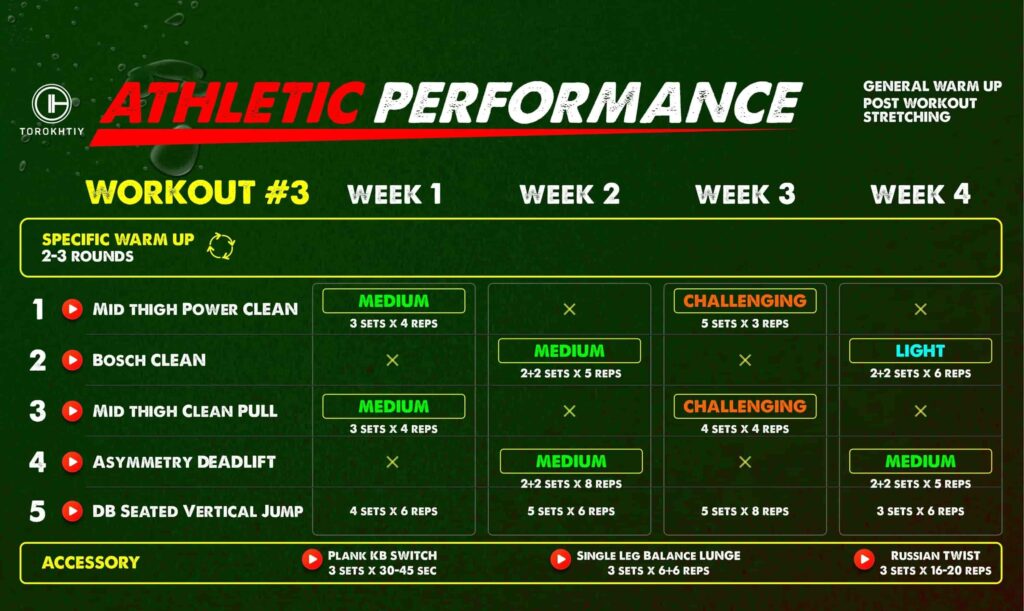
Strength training for runners and marathon athletes which is also known as weight lifting consists of specific methods, drills and techniques with some form of resistance to increase total body muscular strength, power, speed, endurance, agility, coordination and prevent injuries.
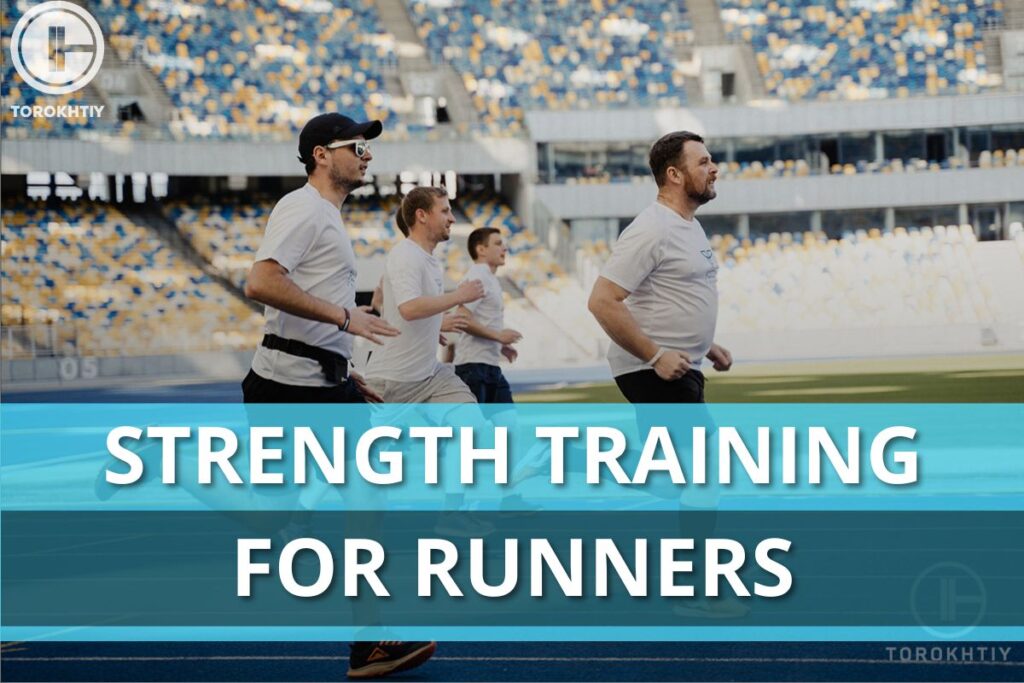
What’s Strength Training for Runners
Not only gym rats and competitive weightlifters engage in strength training. Regular weightlifting and strength training can also help runners improve significantly.
There is an excellent lifting program for runners that will allow you smash personal records or simply run more easily, regardless of whether you have a fully equipped lifting gym or you’re performing bodyweight exercises in your garage or living room.

Strength training benefits your running in a variety of ways, including: speed, power, stamina, coordination, injury prevention. Running enthusiasts worry that weight lifting will result in an increase in body weight and muscular mass.
But, by adding lean muscle with the right strength and resistance training for runners, may increase performance without adding bulk.
This lifting routine for runners focuses on the key muscle groups which will increase your strength and speed rather than cranking out heavy rounds of biceps curls or bench presses. Running engages a variety of muscles that must cooperate in order to move you ahead. Running also doesn’t work individual muscles in isolation.
Benefits of Strength Training For Runners
Your ability to give enough oxygen to your body muscles and heart will largely determine how well you perform as a runner. The characteristic of aerobic exercise is that.
Weight lifting is an anaerobic kind of exercise, which means it uses no oxygen to convert carbohydrates into energy. Hence, adding weight to your routine won’t help you boost the amount of oxygen getting to your muscles from your lungs.
You shouldn’t suppose that’s the sole factor affecting running performance. For enhancing your results, running strength training plan offers numerous important advantages. Let’s take a look at them now.
Lifting Makes You Faster
You get quicker when you lift weights. According to studies, strength training for marathon runners improves VO2 max, running economy and efficiency through enhancing power and muscular coordination.
In particular, it has been discovered that lifting weights reduces the amount of energy and oxygen that runners consume when running by 2–8%, boosting time trial efficiency by 2–5%.
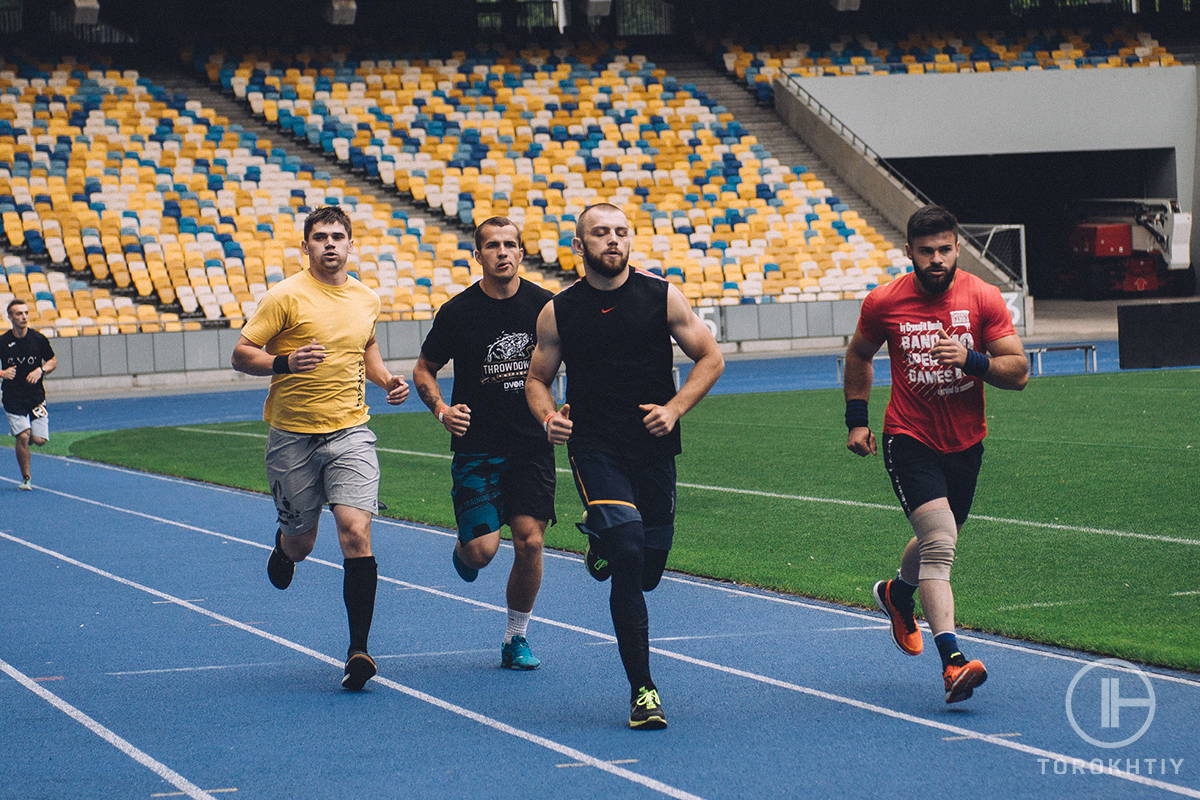
Sprinting Speed
You might not think that your sprinting speed is essential to your success if you are a distance runner. It is true that the single most crucial indicator of your ability and potential to run is likely your peak oxygen consumption.
The highest level at which your muscles can use oxygen is known as VO2 max. You run a specific distance quicker the higher VO2 max. Yet, there are other factors that affect your running performance in addition to aerobic capacity.

Also, you gain from improved anaerobic ability and a faster maximum running speed over shorter distances. Competitive runners are likely familiar with mid-race sprints and abrupt accelerations. You best be ready to move more quickly when they do so or you’ll fall behind. Also, a dash to the finish line decides the outcome of many races.
After a long run, your ability to sprint with all you might can be the difference between winning and losing a race. Gaining the ability to run as quickly as you can at the beginning of a race is the third advantage of increasing your sprinting speed. You may not only set up your body in the way you like, but you can also run better overall, especially in shorter events.
Performance over a longer range improves as maximal sprinting speed rises. While that primarily applies to running for distances up to 1,500 m, other studies indicate advantages for distances of 10 m or more.
Tips From the Champ
Concerning weight training, particularly working out with a barbell, it’s important to control the speed of movement. Meaning, it’s better to take a lighter bar and perform exercises quicker to develop explosive power. If a runner is focusing on performing more repetitions, the speed of movement also plays crucial role because the key point is not how much weight they can pull, but how to deal with those weight and transform kilos into promoting their running technique.
Pro Runner, Silver in EU Champ
Early studies showed that short-distance runners’ sprinting performance is enhanced by strength training. Strength training plan for runners enhances your ability to sprint 20–30 m as quickly as possible throughout longer races, according to a more recent study.
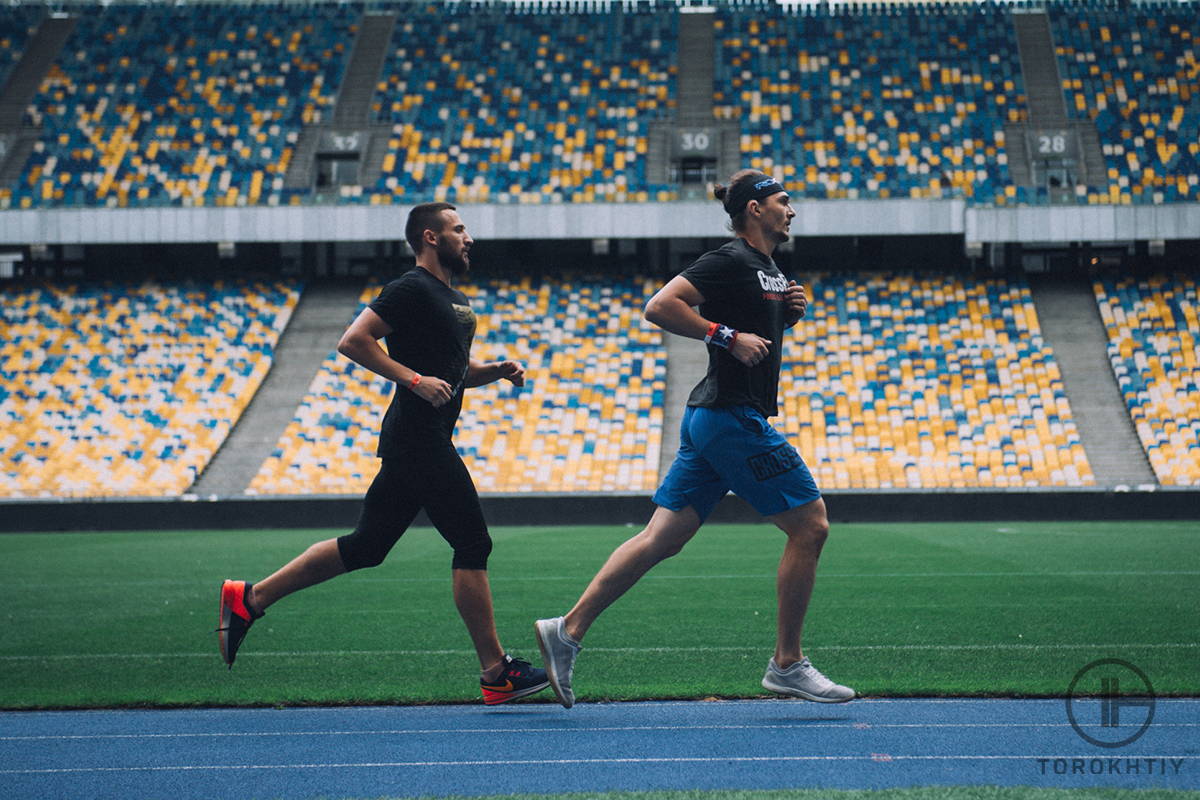
Injury Рrevention
Strength and power training help runners avoid injuries since it strengthens their bones, muscles, and connective tissues. For several reasons, strength training is an extremely useful technique for preventing injuries.
Muscles, tendons, even ligaments and bones get stronger with strength exercise. A body with stronger ligaments and muscles is better able to maintain alignment when moving.
Follow us!

Free!
Get a 2-week Weightlifting Program as a bonus for the subscription to kickstart your training plan!

Free!
Better Overall Health
Lifting helps runners’ overall health. Strength training program for runners improve your self-assurance, mental toughness, and health indicators including blood sugar, BMI, cholesterol, and fat-burning capacity.
Running Economy
The quantity of energy and oxygen your body requires to keep up your running speed is known as the running economy. Addition of weight training to running programs can increase running economy by up to 8%, according to several reviews and meta-analyses.
On the track or road, in a real-world scenario, greater running economy should enable you to run at a substantially lower effort, resulting in appreciable performance gains throughout a training or a race. You should expect to increase your performance and running economy by lifting in addition to running, regardless of your level of training, whether you are a moderate or well-trained athlete.
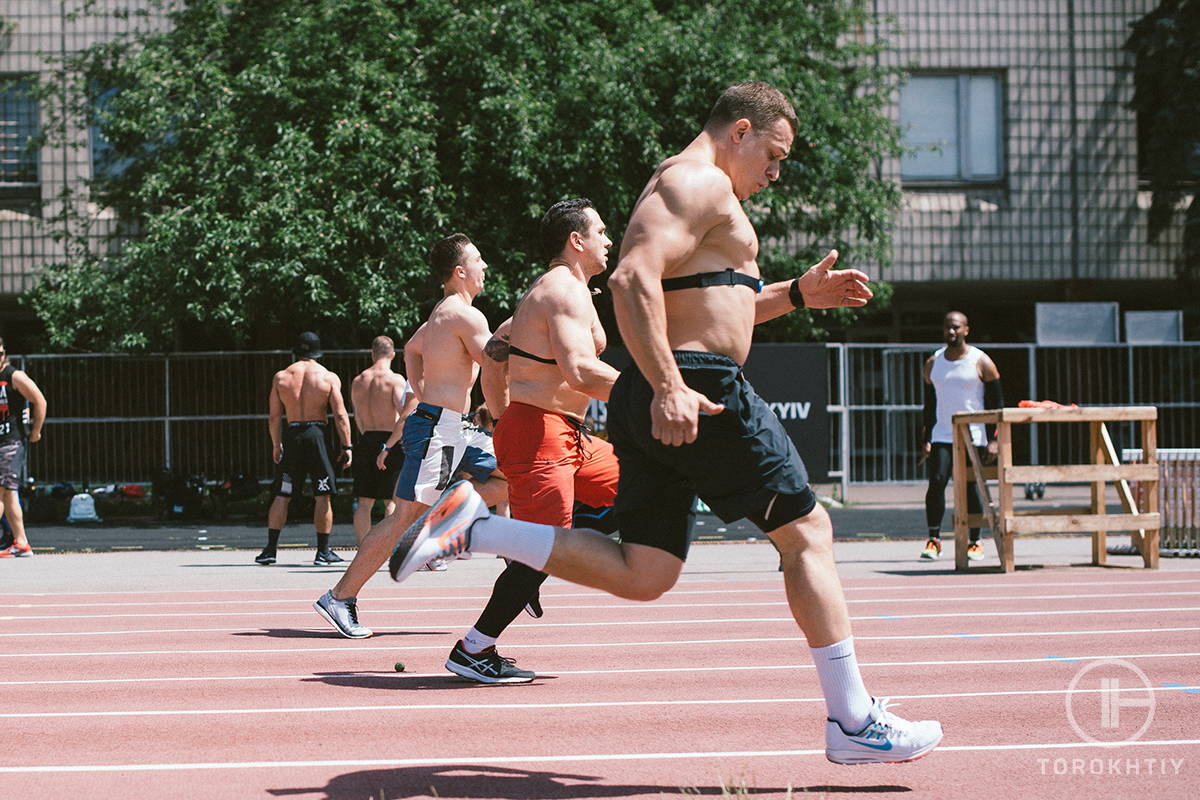
Strength Training Exercises for Runners
There are many excellent weight training programs for runners to do to build strength, but these ten drills are the most optimal. They will serve as the ideal starting point for moving on to more complex variants and new moves.
An Olympic barbell, cable machine or rubber band, mat and some space – all you need. You can perform 2-4 sets of each exercise, with 8 to 12 reps each exercise, depending on how you’re feeling and your fitness objectives.
Deadlift
Your knees should be slightly bent while you take position with feet hips width apart and most of your weight on your heels.
Move hips back and lean forward while maintaining a straight & tight lower back and chest open.
Lift the bar up to standing after lowering it to around knee height. Keep your knees soft and your hips motionless.
Single-Leg Deadlift
One of the finest movements for the glutes is the single-leg deadlift. You acquire balance and strength, allowing you to always advance to components of power.
Place your feet hip-width apart as you stand. Raise the left leg off the ground while flexing the foot and bending the knee to 90 º. Keep your left toes just barely contacting the ground to adjust.
To drop the body towards the floor, slightly flex the right knee and then bend at the hips. Keep your core tight and your chest high.
Drive through the right foot to swing back to the initial position after continuing to hinge until the torso is virtually parallel to the floor.
Reverse Lunge
A reverse lunge exercise is a fantastic solution for improving single-leg stability and lower body strength. Dumbbells or kettlebells are the most popular to load a back lunge, but there are other options.
Place your hands in front of your chest and stand with your feet hip-width apart. Step back with your left foot while putting most of your weight on your right leg. Step back with your left foot, bend at the hips, and lean forward as necessary while maintaining a tall posture.
In order to barely skim the floor, lower your left knee towards it. The right heel remains firmly planted. To get back up to standing, drive through the right leg.
Walking Lunge
Consider walking lunges as a much slower version of the motions you perform when you run. You may develop strength while going ahead by performing walking lunges. Stand with your arms at your sides and your feet hip-width apart. Step forward with your right leg as you hinge your hips and bring your left knee all the way to the floor, bending it at a 90º angle.
To stand up again, push through both of your feet. Stop, tap the left foot softly on the right foot, or go to the next lunge. Step forward with your left leg, hunching your hips, and dropping your right knee towards the floor. Repeat with your opposite leg.
Single-Arm Standing Cable Machine Row
A lot of essentials for running are covered by this movement. Core strength, excellent posture and upper-body strength are necessary for efficient running. All those objectives are satisfied by this exercise. Resistance bands that are attached to a squat rack, can also be used for this technique. Holding a cable between your waist and chest height with your right hand, take initial position in front of the machine with your feet hip-width apart and take a step backward.
Legs should be slightly offset such that the right foot is a bit behind the left. Pull back towards the hips, leading with the right elbow, starting with the right arm straight. When drawing weight back, keep your lower body steady to avoid your hips from twisting to the right. This motion allows for a small rotation of the upper body. Return to the initial position by slowly releasing the cable and completely extending the right arm.
Single-Arm Standing Cable Machine Horizontal Press
One of the best drills for the upper body is the unilateral cable press. It also has core control, which is advantageous. While it is done in a controlled manner, this action can mimic the motion of running. Resistance bands can also be used for this running strength workout, which is similar to the single-arm row.
Stand with your back to the cable machine. Hold the cable close to shoulder height with the left hand in front of the left shoulder, the left elbow out to the side in one line with the left shoulder. For a greater difficulty, feet might be lined up or staggered. Press the left hand straight forward in front of the body as if you were punching, with the palms towards the ground and the knuckles pointing forward.
Leaning slightly forward, slowly pull the weight back towards the chest while keeping the hips motionless. Do not allow the weight to cause you to slouch.
Pallof Press
Have you never heard of Pallof Press? It’s wonderful for enhancing strength endurance and core stability. Again, if you don’t have a cable machine, you may use a resistance band. Standing parallel to the machine with your left side to the machine and your feet hip-width apart, keep your arms at your sides. For less resistance, stand closer; for more resistance, stand farther away from the anchor point.
Rotate your body towards the machine while keeping your knees soft and your core active. Grip the handle with your hands. To face forward with hands straight in front of the chest, spin your body away from the machine using your core. Here is where everything begins.
Lengthen your arms and push your hands out from your body. The movement must be regulated, smooth, and without any momentum. Avoid bending your body in the direction of the machine. Return slowly to the initial posture, tucking elbows next to ribs as you go. Throughout the exercise, the hands should stay at chest level.
Superman
Although superman variations, sometimes referred to as back extensions, are a terrific bodyweight exercise to undertake, strengthening your back may occasionally be challenging without weights. They aid in the strengthening and stabilizing of your lower back, which will help you maintain good running form. Before lowering yourself back down, hold the superman position for 2-3 seconds at the peak of the exercise.
Plank
The planks are a traditional core exercise for runners since it engages almost all of the muscles in your midsection as they struggle to maintain your suspension of the body. On your forearms, do a basic plank. You may even go to other plank variants like plank walk-ups.
Russian Twists
Russian twists help to stabilize your spine and enhance general balance. Bring your legs straight out as you sit down on the ground. Brace your abdomen to activate your core while you lean back a little so that your legs and body form a V-shape. While maintaining your balance, rotate your body from side to side while keeping your legs still. Breathe and rotate slowly, always. To make it harder, add a heavy ball or any other weight.
Key Factors in Runners Strength Training Routine
When Should a Runner Begin Weight Lifting?
Weight lifting plan for runners may be used at any time into a training routine. Running enthusiasts should begin weight training, however, during the off-season or low intensity stages of training.
They should begin with bodyweight and light weights. In this manner, the stress brought on by weightlifting won’t affect how well you run. And don’t think that just because you’re in terrific cardiovascular form that it will be simple. Plan on being sore for the first several weeks after starting, but don’t let that stop you!
How Frequently Ought Runners to Lift?
Some weight training is preferable than none when that comes to runners. Weight training for marathon is recommended twice a week, but if you can only fit in one session, go for it! It is more than adequate to exercise twice a week to improve without becoming overly exhausted.
How Much Time Should Be Spent Lifting Weights?
Each weight-training session should last 30 to 60 minutes and include 6 to 8 movements with 2-4 sets of 8-12 reps. It will take an hour to complete a full-body workout.
How Much Load Should Runners Lift?
A high-intensity with low volume approach to weight lifting for runners can help them become stronger while reducing tiredness. If runners don’t lift hefty weights, they are losing their time. Lifting light weights enhances muscular endurance, which is unnecessary because running already does so.
In order to increase their power and strength, runners should instead:
- lift weights with low and average rep range;
- max out at 6-10 rep range;
- mostly work with weights around 75% of your 1 RM;
- perform strength training at least 2 times a week.
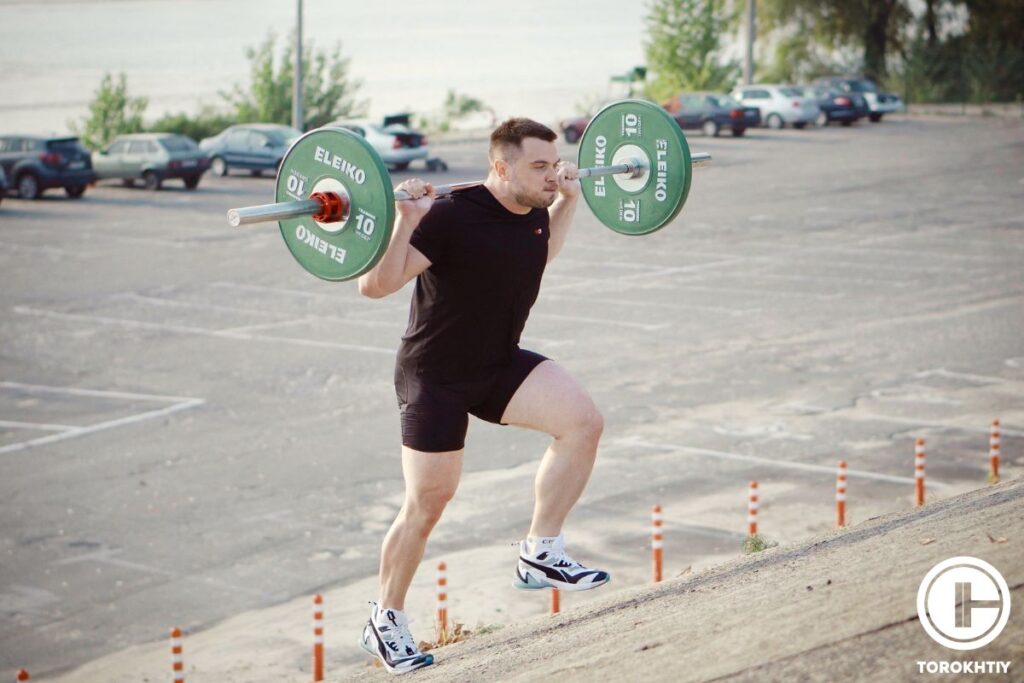
Running prevents muscles from growing too big, according to research, so runners don’t need to be concerned about bulking up. Running is a catabolic activity, so you won’t be able to add a lot of muscle.
How Can You Incorporate Weightlifting Into Your Running Routine?
As a runner, it is crucial to lift weights since the strain athletes apply on his muscles can directly affect how well you run.
Runners should generally do the following for the best gym workout:
- lift weights on intensive running days;
- exercise with weights after running;
- wait around three hours before lifting after an intensive running
- never lift weights before a high intensity running workout;
- not lift on light running days unless in a basic period phase;
When you’re in a transition period the timing of marathon strength training is less important. But it’s recommended to lift the day after a high-intensity running session.
According to studies, athletes should rest for 24 to 48 hours following strength training before engaging in a high-intensity running practice. Lifting routine for runners before a workout increases the likelihood that you won’t succeed in it and makes recovery take longer. To ensure that your muscles recover, give them at least 2 days of rest. Take care of your body and don’t misuse it, since runners require strong muscles for greater performance and faster speed. Also, it’s crucial to taper before a competition. Running athletes can reduce their strength training by skipping a session and working out just once per week for two weeks.
Runners Strength Training Programming
Check out this strength training strategy designed for runners by 3 training days:
Day 1: Lower Body Focus
1. Deadlift: 4 sets x 5 reps
Focus on explosive concentric phase
2. Reverse Lunge: 3 sets x 8 reps per leg
Emphasize control and depth
3. Barbell Squat Jump: 4 sets x 5 reps
Perform explosively, with full hip extension
4. Single-Leg Box: Jump 3 sets x 6 reps per leg
Focus on soft landing and stabilization
Day 2: Upper Body & Core Focus
1. Single-Arm Standing Cable Machine Row: 3 sets x 10 reps per arm
Pull explosively and control the return
2. Single-Arm Standing Cable Machine Horizontal Press: 3 sets x 8 reps per arm
Emphasize stability during the press
3. Pallof Press: 3 sets x 10 reps per side
Hold each repetition for 2-3 seconds for anti-rotation
4. Landmine Rotations: 3 sets x 8 reps per side
Focus on explosive rotation with control
Save it for easy access!
Bookmark this page now to access the program and instructional videos anytime, anywhere.
Stop wasting time searching during your gym sessions.
Day 3: Full Body Focus
1. Walking Lunge: 4 sets x 10 reps per leg
Focus on deep lunges and a powerful stride
2. Single-Leg Deadlift: 3 sets x 8 reps per leg
Maintain balance and control
3. Banded Kettlebell Swings: 3 sets x 15 reps
Emphasize hip drive with added resistance
4. Russian Twists: 3 sets x 15 reps per side
Keep the core engaged throughout
Volume and Intensity Guidelines:
Warm-Up: Start with dynamic mobility and activation exercises.
Rest Intervals: 2-3 minutes for main set lifts, 1-2 minutes for accessory exercises.
Load: Start at 50-60% of your 1RM, increasing by 5-10 lbs weekly.
Accessory Exercises: Moderate intensity to focus on stability and injury prevention.
Basic Equipment You Need
The list of necessary equipment for lifting and strength training is endless, however the list below should be helpful: Olympic barbell and plates, machines, kettlebells, dumbbells, rubber band variations, heavy med balls.

FAQ
How Often Should I Run?
Depending on a number of variables, including fitness level, running objectives, experience, general health, and age, the appropriate running frequency will differ greatly from runner to runner. More experienced athletes can run between 5 and 6 days a week, planning at least 1 rest day to ensure that the body recovers properly. Beginners who are more oriented on goals, such as finishing their first 5k, should begin with 2-3 days of run/walk intervals.
Should Runners Do Strength Training?
Without a doubt, sure. Two times each week, runners must strength train with total-body exercises. For runners, strength training provides a plethora of advantages, including minimizing overuse injuries and enhancing form, efficiency, and performance in general. Incorporate complex movements in your workouts, including deadlifts, lunges, glute bridges, planks, step-ups, rows, and push-ups.
How Can I Treat Sore Body Muscles?
There are a few techniques you may do to treat these bothersome muscle pains if you are sore from strength training or running, such as engaging in active recovery activities, such as, stretching, yoga, swimming, rowing or walking, foam rolling, sauna applying ice to the afflicted muscles for a short period of time, or massaging them.
Conclusion
By giving strength exercise priority, you should become more robust and improve your bone density, tendon health, and muscle health. And this is before you even consider the performance advantage that strength training also provides. The last benefit of strength training is that it may help you identify any areas of imbalance in your body that need treatment if you want to avoid becoming injured.
Also read:
Why Trust Us?
With over 20 years in Olympic weightlifting, strength training, nutrition coaching, and general fitness our team does its best to provide the audience with ultimate support and meet the needs and requirements of advanced athletes and professional lifters, as well as people who strive to open new opportunities and develop their physical capabilities with us.
By trusting the recommendations of our certified experts in coaching, nutrition, and sports training programming, as well as scientific consultants, and physiotherapists, we provide you with thorough, well-considered, and scientifically proven content. All the information given in the articles concerning workout programming, separate exercises, and athletic performance, in general, is based on verified data.
The product testing process is described in more detail here.
Author: Oleksiy Torokhtiy
Olympic Weightlifting Champion, PhD in Sport Science
Best Results: Snatch – 200 kg,
C&J – 240 kg
Oleksiy Torokhtiy is a professional athlete boasting 20 years of experience in Olympic weightlifting. With multiple European and World titles under his belt, he has showcased his prowess in two Olympic Games (Beijing 2008 and London 2012). Upon concluding his illustrious career, Oleksiy dedicated himself to coaching. By 2022, he had conducted over 200 weightlifting seminars worldwide. He is the visionary behind an international sportswear and accessories brand known for its motto, “Warm Body Cold Mind.” Additionally, he is an esteemed author and the creator of a series of training programs and eBooks.
Reviewed by: Viktoriya Tkachuk
Ukrainian Professional Athlete
Best Results:
400 metres hurdles is 53.76 seconds
2nd place in European Championships in 2022
Ukrainian athlete specialising in the 400 metres hurdles. She won the silver medal in the event at the 2022 European Athletics Championships.
Tkachuk represented Ukraine at the 2016 Rio Olympics without advancing from the semi-finals, and at the 2020 Tokyo Olympics, where she placed sixth in the final.




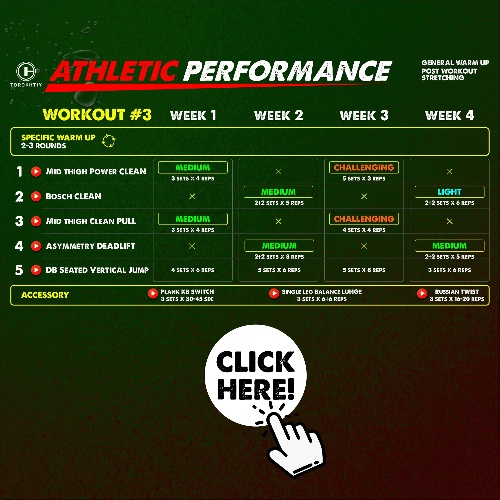




Still have questions after reading our article? Unlock your full potential by engaging with our experts and community! Don’t hesitate — leave a comment below and Oleksiy Torokhtiy will provide a personalized answer and insights to help you reach your goals.